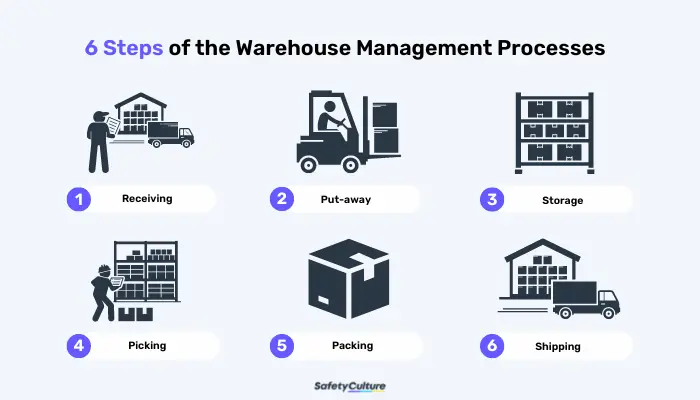What is Warehouse Management?
Warehouse management is the overall process of overseeing the day-to-day operations of a warehouse. This includes the major procedures involved in ensuring the smooth performance of activities such as receiving, inventory, storage, packing, and shipping of products out of warehouses. Warehouse managers, inventory managers, and logistics providers employ warehouse management to streamline product tracking, show accurate inventory levels, and increase warehouse efficiency.
Warehouse Management vs Inventory Management
Warehouse management and inventory management are often used interchangeably which sometimes leads to confusion over their primary purpose and distinctions. So, what is the main difference between the two?
Inventory management deals with the more specific business unit that focuses on making sure that there’s an accurate number of products, goods, or services readily available in the supply chain. It uses relevant information such as sales trends, historical data, and seasonal demands to forecast the stock levels needed to fulfill market needs. Inventory management also includes handling raw materials, item components, and finished products.
Warehouse management, on the other hand, is a more general and broad unit that includes a review of all the aspects considered in maintaining warehouses such as warehouse design, lay-out, geography, item tracking, and reporting. Warehouse management also observes the policies and procedures involved in efficient warehouse operations through resources including people, equipment, and finished products.
In addition, warehouse management is ideal for bigger companies with complex operations while inventory management is sufficient for smaller-sized businesses—depending on their prominent needs.
Why is it Important?
According to a study released by Oracle, 82% of American consumers worry that delays in deliveries or other forms of disruption in the supply chain negatively impact their way of life. As an essential component of the transport and logistics industry, warehouse management plays a huge role in the supply chain. Businesses implement warehouse management for various reasons but why is it an important factor in achieving a highly-efficient business logistics?
- Controlled inventory levels – Real-time information from a properly managed warehouse helps ensure a more accurate level of inventory. This reduces discrepancies between the demand and supply of the products, thus, minimizing unnecessary costs for the company.
- Improved customer service – Warehouse management also indirectly affects the customer experience. When orders are prepared, delivered, and fulfilled in a timely and accurate manner, this can create a lasting positive impact on customers. Observing the ideal stock number of in-demand items and making sure that they are available as needed, also leads to satisfied and happier customers.
- Increased productivity – Using data-driven approaches, warehouse managers can decide whether to place commonly-used materials near production, packing, or shipping areas. Warehouses can also optimize space use by determining the best design applicable to the specific warehouse. These practices allow businesses to do things efficiently, which in turn, improves team productivity.
Warehouse Management Process
The warehouse management process is composed of six major steps that are highly dependent on each other. Every optimized process would affect how the next ones would perform so it is crucial to ensure that each one is operating according to its ideal functions. Below are the six core processes of warehouse management:

Step 1: Receiving
Warehouse receiving is the first and one of the most important processes of warehouse management. This step requires receivers to check incoming items and make sure that they are of the right quantity, are functioning properly, and are received promptly.
Receiving can somehow be considered as the business’ first layer of protection against unnecessary expenses. During this stage, warehouse receivers can identify items that aren’t at par with expectations, send them back to the suppliers, and therefore save the company from potentially costly damages.
Step 2: Put-away
Put-away is the second warehouse management process where the items received will be moved from the receiving docks onto their most ideal storage locations. An efficient and accurate put-away process ensures the safety of employees and the safe storage of items. It also helps maximize space allocation, eases tracking of items, and minimizes traveling time of products—which all ultimately enhance the whole warehouse experience.
Step 3: Storage
In the storage process, it is important to keep items in their most appropriate location throughout the warehouse. Considerations include safety, space, and efficiency. To achieve optimum use of the facilities, warehouse managers can ask questions along the lines of:
- Are the items safely stored in the appropriate location in the warehouse?
- Are perishable items stored in areas with appropriate climate control?
- Are items stored in a way that maximizes the storage spaces available?
- Are items stored in a manner that they are easy to track and are highly visible?
- Are items easily accessible to employees as needed?
Step 4: Picking
Picking, as the name suggests, is the warehouse management process where employees locate and pick up individual items across the warehouse to fulfill orders. This is one of the most crucial steps in the whole process because it is directly tied to customer satisfaction.
The process of picking is also one of the most labor-intensive and most expensive activities for warehouses. So, optimizing this step not only enables businesses to efficiently manage orders but also to reduce errors, drive profit, and strengthen company reputation.
Step 5: Packing
Next, we have the process of packing or packaging. This is the part where all the picked items for a specific customer are consolidated and prepared to be delivered. Considerations that have to be observed include components such as accurate packing slip, appropriate packaging materials (especially for fragile items), and the ideal packaging weight.
The primary goal of packing is to ensure that items will be safe and damage-free the moment they leave the premises of the warehouse until they are delivered to the customers.
Step 6: Shipping
Shipping or delivery is the culmination of all the previously-mentioned steps of warehouse management. With this process, relevant staff sends out the finalized orders while ensuring that the appropriate transportation mode is utilized to bring the items to the customers.
Shipping is only considered successful if the items are delivered with the correct documentation, at the right time, and according to the expected quality.
Digitize the way you Work
Empower your team with SafetyCulture to perform checks, train staff, report issues, and automate tasks with our digital platform.
Get Started for FreeTop Challenges
Because there are several processes, people, and strategies involved to ensure its smooth operation, the industry of warehouse management also encounters numerous challenges. Aside from human errors and issues with warehouse safety, the following are some of the top challenges that the warehouse sector commonly faces:
- Skills gap – Currently, one of the top challenges that the industry of warehouse, transport, logistics, and the whole supply chain faces is the skills gap and driver shortage. In the United States, there’s a historic truck driver shortage of 80,000 just in the year 2021 alone. While the UK continues to experience Heavy Goods Vehicle (HGV) driver shortage caused by an aging workforce, lack of diversity in the industry, reliance on the international workforce, and other covid-related factors. Both of which are still being addressed by the industry and the government themselves.
- Low visibility – Manually monitoring warehouse items can be very overwhelming and prone to mistakes. Minimal visibility can also lead to overstocks, inadequate use of space, and inaccurate inventory. To address this, businesses have the option of utilizing tracking tags such as Radio-Frequency Identification (RFID) tags, barcodes, or QR codes.
- Delays in processes – An unoptimized warehouse operation is prone to inefficiencies and slower progress of activities. These issues not only affect the warehouse process itself but can also impact customer satisfaction if delays are noted during order fulfillment.
- Damaged products – If warehouse items are received, stored, or shipped improperly, this causes significant damages to products and goods. Accumulating damaged items is a costly expense for businesses and their reputation would be at stake if it frequently affects customers.
- Demand volatility – A lot of factors go into the concept of supply and product demand—holidays, seasonal changes, extreme weather, and economic situation are just some of these. Having accurate and real-time information while ensuring that the supply chain is managed properly, can help combat this challenge.
- Non-automated process – Warehouses that still rely on manual processes of checking, inspecting, tracking, and documenting warehouse items are at numerous disadvantages. These weaknesses can be along the lines of higher labor costs, larger inventory discrepancies, and slower order fulfillment.
To combat these challenges, businesses can always utilize tools or new technologies that could streamline warehouse operations and improve efficiency.



